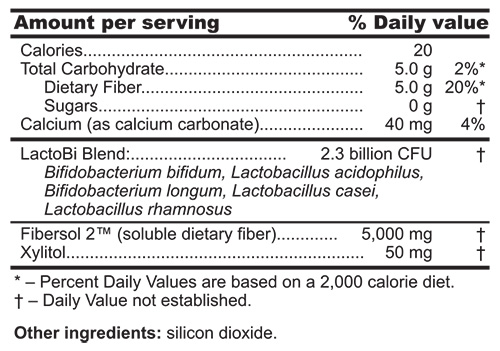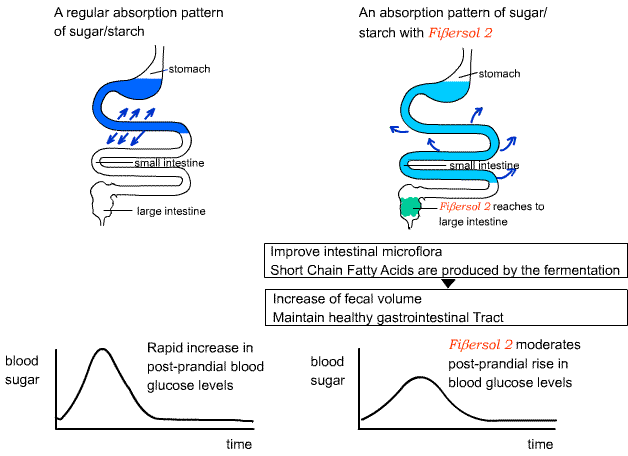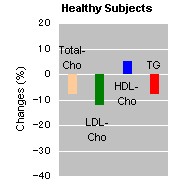Contraindication
LactoBi Complex (14) contains 5 forms of probiotic bacteria for maximum effectiveness and Fibersol 2™ - the patented form of dietary fiber that is classified as "resistant maltodextrin" that supports the growth of probiotic bacteria.
The product has been manufactured using high quality pure raw materials and the technology that ensures all their beneficial properties intact, in strict compliance with GMP and TÜV regulations.
The intestinal microflora of a healthy human body has about 400 different bacteria: some of them are “friendly” for us - help with the food digestion, eliminate waste products from the body, participate in vitamin synthesis and nutrient assimilation, help fight the diseases. These bacteria are called probiotics or eubiotics. The most important among them are Lactobacillus species and Bifidobacterium species.
There are also harmful bacteria in our intestines. The balance between “good” and “bad” bacteria is a key to good health. Unfortunately, some of the food we eat and medication we take (especially antibiotics) can destroy the good bacteria. As a result, the harmful bacteria spread fast and cause damage to our health.
Santegra®’s formula - LactoBi Complex (14) will help you to avoid these problems. This unique formula contains Bifidobacterium bifidum, Lactobacillus acidophilus, Bifidobacterium longum, Lactobacillus casei, Lactobacillus rhamnosus.
Probiotic bacteria help to maintain the balance of intestinal microflora, suppress the growth of pathogenic bacteria, and improve digestion. The intestinal microflora is important for the immune system. Probiotic bacteria reinforce the barrier function of the intestinal mucosa, helping in the prevention of the attachment of pathogenic microorganisms and the entry of allergens.
“Friendly” bacteria have been shown to benefit digestion, and to inhibit the growth of harmful bacteria in the body.
The digestive processes of Lactobacillus Acidophilus, for example, effect the production of byproducts, such as lactic acid and hydrogen peroxide, which ultimately alter the gastrointestinal environment and discourage "bad" organisms from forming within our body.
Lactobacillus Acidophilus also boosts the immune system function by producing a substance called bacteriocin, which acts as a natural antibiotic in the eradication of potentially harmful organisms.
Probotics help to prevent vaginal yeast infections. The researches show that intra-vaginal or oral administration of Lactobacillus Acidophilus can prevent the overgrowth of Candida albicans.
Probotics improve digestion and metabolism. Probiotics may also reduce the risk of gastrointestinal disorders. According to several studies, regular use of acidophilus and other probiotics can help prevent "traveler's diarrhea". These microorganisms are vitally important after antibiotic treatment to restore the “friendly” bacteria colony.
LactoBi Complex (14) contains Fibersol 2™ – a soluble dietary fiber that supports the growth of probiotic bacteria, has positive effects on blood glucose and cholesterol levels, and improves bowel movement regularity that help prevent many diseases.

Mix one packet with water or milk. Drink immediately. Use once a day as a dietary supplement.
Contraindication
Lactobacilli are one of the most important types of friendly bacteria found in the digestive tract. These bacteria get their name (lacto) because they are able to form lactic acid. Lactobacilli help to normalize the balance of the intestine microflora, because the lactic acid creates such environment in the intestines that is not suitable for the survival of the “bad” bacteria.
Lactobacillus acidophilus is the most commonly used probiotic, or "friendly" bacteria. Lactobacilli acidophilus inhabit the intestines and vagina and protect against the entrance and proliferation of "bad" organisms that can cause disease. These bacteria protect urinary tract against Candida albicans, boost the immune system function, and help to restore the balance of intestinal microflora after antibiotic therapy.
Clinical trials show that Lactobacillus casei is effective for treatment of harmful bacterial overgrowth, helps to decrease the duration of diarrhea caused by antibiotic therapy and traveler’s diarrhea. Lactobacillus casei can beneficially alter cholesterol levels and produce a healthier bowel microbial population.
Lactobacillus rhamnosus inhibits the growth of most harmful bacteria in the intestine, effective against diarrhea; helps to remove toxins from the intestines.
Bifidobacteria are one of the major genera of bacteria that make up the gut flora, the bacteria that reside in the colon. Bifidobacteria are a natural part of the bacterial flora in the human body and have a symbiotic bacteria-host relationship with humans. Bifidobacteria improve digestion, help to maintain normal intestinal microflora, aid in the synthesis of the B vitamins.
When you take antibiotics, the "friendly" bacteria in your digestive tract are destroyed along with the harmful bacteria. Bifidobacterium bifidum helps to normalize intestine microflora after antibiotic therapy, strengthens the immune system. Bifidobacterium bifidum helps to improve bowel regularity.
Bifidobacterium longum is among the first bacteria colonizing the intestine of breast-fed infants. Bifidobacterium longum promotes good digestion, boosts the immune system, and promotes bowel regularity. These bacteria produce lactic and acetic acid that helps control intestinal pH, and inhibit the growth of harmful bacteria.
LactoBi Complex (14) contains Fibersol 2™ - a soluble dietary fiber that is produced from cornstarch by pyrolysis and subsequent enzymatic treatment. Fibersol 2™ is classified as "resistant maltodextrin". One of its benefits is stability to acid and heat/retort processing.
Fibersol 2™ is fermented slowly, thus producing less acid and gas than most soluble dietary fibers. The left picture shows a regular absorption pattern of sugar/starch. The most part of it is absorbed in the stomach. The right picture shows the process of absorption of sugar/starch with Fibersol 2™. Only a small part is digested in the stomach, most of it reaches large intestine and is used as a food for beneficial bacteria, normalizes the intestine microflora, increases the fecal volume.

Pic.1
Fibersol 2™ slows absorption that is beneficial for the blood glucose level and regulates the insulin production (pic.1). It is shown that blood glucose level rise after Fibersol 2™ intake is lower (right diagram).
Ohkuma & Wakabayashi in Advanced Dietary Fiber Technology, 2001, described over ten years of nutritional feeding studies in animals and humans worldwide.
Fibersol 2™:
Helps maintain healthy blood glucose levels and subsequent insulin response.

Studies indicate that Fibersol 2™ can effectively reduce serum blood glucose level, potentially allowing formulation to be used in foods for diabetics, weight control, and managing serum glucose before, during, and after exercise.
Helps maintain healthy levels of blood triglycerides and serum cholesterol.
Fibersol 2™ significantly reduces levels of blood triglycerides and serum cholesterol. Additionally, Fibersol 2™ effectively retains levels of HDL (good) cholesterol. All this potentially impacts the incidence of coronary heart disease and related diseases.
Fibersol 2™ lowers serum cholesterol levels and triglyceride levels but does not reduce HDL-cholesterol levels.
Helps maintain healthy intestinal regularity.
 By adding stool volume, moisture, and reducing transit time, Fibersol 2™ helps maintain good colon health, potentially reducing the incidence of various types of colon diseases. In addition, Fibersol 2™ has been shown to prevent atrophy of the lining of the large intestine and does not create excess gas associated with some soluble dietary fibers.
By adding stool volume, moisture, and reducing transit time, Fibersol 2™ helps maintain good colon health, potentially reducing the incidence of various types of colon diseases. In addition, Fibersol 2™ has been shown to prevent atrophy of the lining of the large intestine and does not create excess gas associated with some soluble dietary fibers.
Clinical trial (subjects: 6 males and 14 females prone to constipation) showed that after Fibersol 2™ intake the fecal frequencies increased almost twice.
Fecal frequency study over a 5 day-period: 2.6 times before Fibersol 2™ intake; 4 times after Fibersol 2™ intake (3.75 grams/day).
Helps promote the growth of beneficial bacteria in the colon.
As a water-soluble fiber, Fibersol 2™ can effectively promote the growth of a variety of beneficial bacteria (naturally occurring or ingested as probiotics) in the colon. In promoting the growth of beneficial bacteria, Fibersol 2™ indirectly reduces the presence of undesirable bacterial species.
Department of Food Science, National Chung Hsing University, Taichung, Taiwan.
The antioxidative effect of intact cells and intracellular cell-free extracts of intestinal lactic acid bacteria B. longum (ATCC 15708) and L. acidophilusB. longum and L. acidophilus demonstrated antioxidative activity, inhibiting linoleic acid peroxidation by 28-48%. This indicated that these two strains demonstrated excellent antioxidative activity. B. longum and L. acidophilus also showed the ability to scavenge alpha,alpha-diphenyl-beta-picrylhydrazyl (DPPH) free radical, scavenging 21-52%. The intact cells of these two intestinal bacteria demonstrated a high inhibitory effect on the cytotoxicity of 4-nitroquinoline-N-oxide (4NQO). Cytotoxicity of 4NQO was reduced by L. acidophilus by approximately half and by almost 90% by B. longum. Nevertheless, no inhibition of cytoxicity observed for intracellular cell-free extracts of 10(9) cells of B. longum and L. acidophilus. The effect of B. longum and L. acidophilus on inhibiting plasma lipid peroxidation was also evaluated. The results showed that both intestinal strains were able to protect plasma lipid from oxidation at different degrees. The inhibition rates on plasma lipid peroxidation ranged from 11 to 29% for 10(9) cells of B. longum and L. acidophilus. Generally speaking, B. longum demonstrated better antioxidative ability than L. acidophilus in this study. (1)
Small bowel bacterial overgrowth and related diarrhea is a condition that frequently accompanies anatomic disorders, surgically created blind loops or strictures with partial small bowel obstruction and although it is often controlled with antimicrobial therapy, alternative treatment may be needed. The aim of this study was to evaluate the efficacy of an oral probiotic preparation of 2 viable lyophilized strains of lactobacilli (1.5 g each) compared with placebo. Twenty two patients with proven overgrowth and chronic diarrhea are described. In random order and double-blind fashion, 2 groups of patients received identical capsules with both Lactobacillus casei and L. acidophillus strains CERELA (12 patients) (LC) and placebo (10 patients) (P) during three consecutive periods of 7 days each followed by a similar three periods of control after withdrawal. At the end of each period the mean daily number of stools, glucose breath H2 test, and symptoms were considered. Lactobacillus were investigated in feces in both groups at day 0 (baseline), on day 21 of treatment with LC and P and on day 21 after withdrawal. Compared with P a significant reduction in mean daily number of stools was achieved with LC (p < 0.005) at 15 days, and (p < 0.0005) at 21 days and the effect was sustained at 7 days and 15 days (p < 0.005) after withdrawal. With respect to breath H2 level a significant decrease in H2 concentration was noted at 7 days (p < 0.005) at 15 days, and 21 days (p < 0.0001) with LC and only a significant decrease (p < 0.005) was observed at 7 days after withdrawal. No significant changes were observed with respect to symptoms. The Lactobacillus CERELA strains were isolated from the feces in all patients LC (n = 12) on day 21, and by contrast no Lactobacillus were observed except in two patients out of seven patients after withdrawal. In summary, this study provides evidence that LC are effective for treatment of bacterial overgrowth--related chronic diarrhea, and suggest that probiotics must be used with continuity. (2)
Probiotic bacteria exhibit a variety of properties, which are unique to a particular strain. Lactobacillus acidophilus-SDC 2012, 2013 are new strains isolated from Korean infants' feces. The potential utility of Lactobacillus acidophilus-SDC 2012, 2013 in irritable bowel syndrome (IBS) was studied. Forty IBS patients were randomized into a placebo (n = 20) and probiotics group (n = 20). Four weeks of treatment with L. acidophilus-SDC 2012, 2013 was associated with a reduced score for abdominal pain or discomfort compared to the baseline (P = 0.011). The percent reduction in abdominal pain or discomfort exceeded the placebo scores by more than 20% (23.8 and 0.2% for probiotics and placebo, respectively, P = 0.003). There was a significant difference in the proportion of responders between the probiotics and placebo groups (P = 0.011). There was no drop out or adverse events for either group during the study period. Lactobacillus acidophilus-SDC 2012, 2013 appeared to have a beneficial effect in patients with IBS. Further studies are warranted. (3)
This review considers whether probiotics are effective agents for the treatment and/or prevention of bacterial vaginosis (BV). There seems to be an association between the absence of, or low concentrations of, vaginal lactobacilli and the development of BV. Many studies have suggested that the presence of H2O2-producing vaginal lactobacilli may protect against BV, although some studies do not support this hypothesis. In-vitro studies have suggested that certain specific strains of lactobacilli are able to inhibit the adherence of Gardnerella vaginalis to the vaginal epithelium and/or produce H2O2, lactic acid and/or bacteriocins, which inhibit the growth of bacteria causing BV. Most clinical trials showed that intra-vaginal administration of Lactobacillus acidophilus for 6-12 days, or oral administration of L. acidophilus or Lactobacillus rhamnosus GR-1 and Lactobacillus fermentum RC-14 for 2 months, resulted in the cure of BV (defined as a 0-1 positive score according to Amsel's criteria), and/or reduced the recurrences of BV, and/or caused an increase in vaginal lactobacilli and restoration of a normal vaginal microbiota, significantly more frequently than did a placebo, acetic acid or no treatment. (4)
Fatigue and impaired performance in athletes is well recognised and has been loosely linked to "overtraining". Reduced concentration of IgA in the saliva and increased shedding of Epstein Barr virus (EBV) have been associated with intense training in elite athletes. OBJECTIVE: To determine whether athletes presenting with fatigue and impaired performance had an immune defect relevant to defective containment of EBV infection, and whether a probiotic preparation (Lactobacillus acidophilus) shown to enhance mucosal immunity in animal models could reverse any detected abnormality. RESULTS: The fatigued athletes had clinical characteristics consistent with re-activation of EBV infection and significantly (p = 0.02) less secretion of interferon (IFN) gamma from blood CD4 positive T cells. After one month of daily capsules containing 2 x 10(10) colony forming units of L acidophilus, secretion of IFNgamma from T cells had increased significantly (p = 0.01) to levels found in healthy control athletes. A significant (p = 0.03) increase in salivary IFNgamma concentrations in healthy control athletes after the one month course of L acidophilus demonstrated in man the capacity for this probiotic to enhance the mucosal IFNgamma concentration. CONCLUSION: This is the first evidence of a T cell defect in fatigued athletes, and of its reversal following probiotic therapy. (5)
Two controlled clinical studies were performed to examine effects of consumption of one daily serving of fermented milk (FM) (yogurt) on serum lipids. METHODS: In the first study, subjects were randomly allocated to FM containing Lactobacillus acidophilus L1 of human origin or to FM containing L. acidophilus ATCC 43211 of swine origin. In this single-blind study, subjects consumed one 200 ml serving of FM daily for 3 weeks. The second study was a double-blind, placebo-controlled, cross-over study. Subjects completed a 4-week first treatment, had a 2-week washout, and completed a second 4-week treatment. In the second study subjects consumed FM containing L. acidophilus L1 or placebo FM over 4 weeks. RESULTS: In the first study, FM containing L. acidophilus L1 was accompanied by a 2.4% (p<0.05) reduction of serum cholesterol concentration. In the second study, strain L1 reduced serum cholesterol concentration by 3.2% (p<0.05) in the first treatment period. In the second treatment period there were no significant changes in serum cholesterol concentration. Combined analysis of the two L1 treatment studies demonstrated a 2.8% (p<0.01) reduction in serum cholesterol concentration. CONCLUSION: Since every 1% reduction in serum cholesterol concentration is associated with an estimated 2% to 3% reduction in risk for coronary heart disease, regular intake of FM containing an appropriate strain of L. acidophilus has the potential of reducing risk for coronary heart disease by 6 to 10%. (6)
Convincing evidence that probiotic administration can lower the risk of antibiotic-associated diarrhoea is limited to certain micro-organisms. AIM: To determine the efficacy of administration of Lactobacillus rhamnosus (strains E/N, Oxy and Pen) for the prevention of antibiotic-associated diarrhoea in children. METHODS: Children (aged 3 months to 14 years) with common infections were enrolled in a double-blind, randomized, placebo-controlled trial in which they received standard antibiotic treatment plus 2 x 10(10) colony forming units of a probiotic (n = 120) or a placebo (n = 120), administered orally twice daily throughout antibiotic treatment. Analyses were by intention to treat. RESULTS: Any diarrhoea (>or=3 loose or watery stools/day for >or=48 h occurring during or up to 2 weeks after the antibiotic therapy) occurred in nine (7.5%) patients in the probiotic group and in 20 (17%) patients in the placebo group (relative risk, RR 0.45, 95% confidence interval, CI 0.2-0.9). Three (2.5%) children in the probiotic group developed AAD (diarrhoea caused by Clostridium difficile or otherwise unexplained diarrhoea) compared to nine (7.5%) in the placebo group (RR 0.33, 95% CI 0.1-1.06). No adverse events were observed. CONCLUSION: Administration of L. rhamnosus (strains E/N, Oxy and Pen) to children receiving antibiotics reduced the risk of any diarrhoea, as defined in this study. (7)
University of Helsinki, Institute of Biomedicine, Pharmacology, PO Box 63, 00014 Helsinki, Finland.
AIM: To evaluate the effects of three potentially anti-inflammatory probiotic bacteria from three different genera on immune variables in healthy adults in a clinical setting based on previous in vitro characterization of cytokine responses. METHODS: A total of 62 volunteers participated in this randomized, double-blind and placebo-controlled parallel group intervention study. The volunteers were randomized to receive a milk-based drink containing either Lactobacillus rhamnosus GG (LGG), Bifidobacterium animalis ssp. lactis Bb12 (Bb12), or Propionibacterium freudenreichii ssp. shermanii JS (PJS) or a placebo drink for 3 wk. Venous blood and saliva samples were taken at baseline and on d 1, 7 and 21. Fecal samples were collected at baseline and at the end of intervention. RESULTS: The serum hsCRP expressed as the median AUC(0-21) (minus baseline) was 0.018 mg/L in the placebo group, -0.240 mg/L in the LGG group, 0.090 mg/L in the Bb12 group and -0.085 mg/L in the PJS group (P = 0.014). In vitro production of TNF-alpha from in vitro cultured peripheral blood mononuclear cells (PBMC) was significantly lower in subjects receiving LGG vs placebo. IL-2 production from PBMC in the Bb12 group was significantly lower compared with the other groups. CONCLUSION: In conclusion, probiotic bacteria have strain-specific anti-inflammatory effects in healthy adults. (8)
Tufts University School of Medicine, Boston, Massachusetts 02111, USA. barry.goldin@tufts.edu
Probiotic bacteria are used to treat or prevent a broad range of human diseases, conditions, and syndromes. In addition, there are areas of medical use that have been proposed for future probiotic applications. Randomized double-blind studies have provided evidence of probiotic effectiveness for the treatment and prevention of acute diarrhea and antibiotic-induced diarrhea, as well as for the prevention of cow milk-induced food allergy in infants and young children. Research studies have also provided evidence of effectiveness for the prevention of traveler's diarrhea, relapsing Clostridium difficile-induced colitis, and urinary tract infections. There are also studies indicating that probiotics may be useful for prevention of respiratory infections in children, dental caries, irritable bowel syndrome, and inflammatory bowel disease. Areas of future interest for the application of probiotics include colon and bladder cancers, diabetes, and rheumatoid arthritis. The probiotics with the greatest number of proven benefits are Lactobacillus rhamnosus strain GG and Saccharomyces boulardii. (9)
Department of Internal Medicine, Kaohsiung Municipal United Hospital, Kaohsiung, Taiwan, Republic of China.
Evidence suggests that ingesting lactic acid bacteria exerts a suppressive effect on Helicobacter pylori infection in both animals and humans. Supplementing with Lactobacillus- and Bifidobacterium-containing yogurt (AB-yogurt) was shown to improve the rates of eradication of H. pylori in humans. OBJECTIVE: We administered AB-yogurt to subjects with asymptomatic H. pylori to test whether the yogurt could inhibit H. pylori growth. DESIGN: The in vitro inhibition of H. pylori growth was determined by inoculating Lactobacillus acidophilus La5 or Bifidobacterium lactis Bb12 on plates that were inoculated with H. pylori. Assessment of the viability of H. pylori was performed by the mixed culture method with La5 or Bb12. In an intervention study, 59 adult volunteers infected with H. pylori were given AB-yogurt (10(7) colony-forming units of both La5 and Bb12/mL) twice daily after a meal for 6 wk. Eleven subjects positive for H. pylori infection were treated with milk placebo as control subjects. H. pylori bacterial loads were determined with use of the (13)C-urea breath test, which was performed before and 4 and 8 wk after the start of AB-yogurt supplementation. RESULTS: Bb12 exerted an in vitro inhibitory effect against H. pylori, whereas La5 did not show an effect. Administration of AB-yogurt decreased the urease activity of H. pylori after 6 wk of therapy (P < 0.0001). CONCLUSION: Regular intake of yogurt containing Bb12 and La5 effectively suppressed H. pylori infection in humans. (10)
This study was designed to evaluate whether probiotics improve symptoms in patients with irritable bowel syndrome. METHODS: PubMed, Embase, Scopus, Web of Science, and Cochrane Central Register of Controlled Trials were searched for studies that investigated the efficacy of probiotics in the management of irritable bowel syndrome. Clinical improvement was the key outcome of interest. Data were searched within the time period of 1966 through September 2007. RESULTS: Eight randomized, placebo-controlled, clinical trials met our criteria and were included in the analysis. Pooling of eight trials for the outcome of clinical improvement yielded a significant relative risk of 1.22 (95 percent confidence interval, 1.07-1.4; P = 0.0042). CONCLUSIONS: Probiotics may improve symptoms of irritable bowel syndrome and can be used as supplement to standard therapy. (11)
1. Lin MY, Chang FJ. Antioxidative effect of intestinal bacteria Bifidobacterium longum ATCC 15708 and Lactobacillus acidophilus ATCC 4356. Dig Dis Sci. 2000 Aug; 45(8):1617-22.
2. Gaon D, Garmendia C, Murrielo NO, de Cucco Games A, Cerchio A, Quintas R, González SN, Oliver G.Effect of Lactobacillus strains (L. casei and L. Acidophillus Strains cerela) on bacterial overgrowth-related chronic diarrhea. Medicina (B Aires). 2002; 62(2):159-63.
3. Sinn DH, Song JH, Kim HJ, Lee JH, Son HJ, Chang DK, Kim YH, Kim JJ, Rhee JC, Rhee PL Therapeutic Effect of Lactobacillus acidophilus-SDC 2012, 2013 in Patients with Irritable Bowel Syndrome. Dig Dis Sci. 2008 Feb 15. Epub ahead of print.
4. Falagas ME, Betsi GI, Athanasiou S. Probiotics for the treatment of women with bacterial vaginosis. Clin Microbiol Infect. 2007 Jul; 13(7):657-64.
5. Clancy RL, Gleeson M, Cox A, Callister R, Dorrington M, D'Este C, Pang G, Pyne D, Fricker P, Henriksson A. Reversal in fatigued athletes of a defect in interferon gamma secretion after administration of Lactobacillus acidophilus. Br J Sports Med. 2006 Apr; 40(4):351-4.
6. Anderson JW, Gilliland SE. Effect of fermented milk (yogurt) containing Lactobacillus acidophilus L1 on serum cholesterol in hypercholesterolemic humans. J Am Coll Nutr. 1999 Feb; 18(1):43-50.
7. Ruszczyński M, Radzikowski A, Szajewska H. Clinical trial: effectiveness of Lactobacillus rhamnosus (strains E/N, Oxy and Pen) in the prevention of antibiotic-associated diarrhoea in children. Aliment Pharmacol Ther. 2008 Jul; 28(1):154-61. Epub 2008 Apr 13.
8. Kekkonen RA, Lummela N, Karjalainen H, Latvala S, Tynkkynen S, Jarvenpaa S, Kautiainen H, Julkunen I, Vapaatalo H, Korpela R. Probiotic intervention has strain-specific anti-inflammatory effects in healthy adults. World J Gastroenterol.
9. Goldin BR, Gorbach SL. Clinical indications for probiotics: an overview. Clin Infect Dis. 2008 Feb 1;46 Suppl 2:S96-100; discussion S144-51.
10. Wang KY, Li SN, Liu CS, Perng DS, Su YC, Wu DC, Jan CM, Lai CH, Wang TN, Wang WM. Effects of ingesting Lactobacillus- and Bifidobacterium-containing yogurt in subjects with colonized Helicobacter pylori. Am J Clin Nutr. 2004 Sep; 80(3):737-41.
11. Nikfar S, Rahimi R, Rahimi F, Derakhshani S, Abdollahi M. Efficacy of Probiotics in Irritable Bowel Syndrome: A Meta-Analysis of Randomized, Controlled Trials. Dis Colon Rectum. 2008 May 9. [Epub ahead of print]